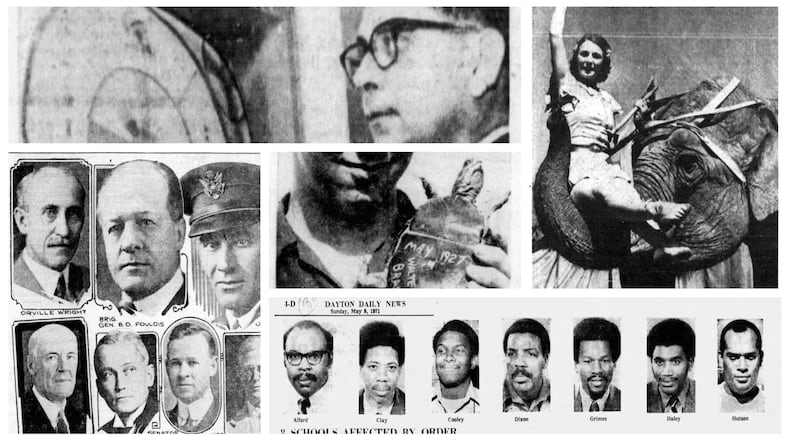Here’s a look at some stories from the week of May 5-11.
May 10, 1931: ‘Home of Aviation’ is ready for greatest air show
The Miami Valley was set to see 672 airplanes flying to and over Dayton in 1931.
For seven days Dayton would once again be the center of the aviation world.
Dignitaries on hand included Orville Wright, Brig. Gen. B.D. Foulois, Gov. George White, Sen. Hiram Bingham, Fred H. Rike and others for the military training event.
Unlike events of the past, which featured combat maneuvers, this year featured an exercise of moving with precision planes from different parts of the country to one place on a schedule, in case of emergency.
Pursuit, observation, attack, bombardment and transport units of every type, 700 officers and 400 enlisted men and mechanics were all involved in the exercise.
Large groups of planes were to be seen flying in formation as if it were wartime.
No less than 100 newspaper writers, special correspondents, magazine writers and still and movie camera operators from all over the country were there to cover the event.
May 5, 1941: Jean Allen and ‘Babe’ arrive for circus in Dayton
Jean Allen and “Babe,” a 70-year-old, five-ton performing elephant of the famous Cole Brothers combined circus, had arrived in town by train for two performances at the Montgomery County Fairgrounds.
The circus was featuring its brand new blue and gold “big top” canvas tent.
The performances featured Allen leading three herds of elephants through demonstrations, climaxing in the stunning elephant mount in the hippodrome track.
Other performers were listed as Polish, Italian and Russian refugees, including the only woman in the world to do a twin-somersault while riding bareback on a horse.
The inside of the tent was an immense American flag.
Another new feature of the circus was in the inclusion of grand opera star Florence Tennyson, a soprano, who sang three songs throughout the circus performance.
The smash finale was a mix of elephants and Tennyson singing “Your Land is My Land.”
May 6, 1951: Old slow poke never left home
One resident turned up in town after 24 years in seclusion.
Being a turtle, his exact whereabouts during his time missing were unknown. But it was certain that he didn’t stray far from the Harrison Twp. area.
The tortoise had “May 1927, Walter Brame” inscribed on his underside. Brame, who by then was a farmer near Springfield, added the historical data when he was living about a half mile from where the turtle was rediscovered.
Kent Wampler,16, found the turtle in the woods behind his home. Upon showing his grandfather, M.E. Wampler, it was discovered that Brame was an old friend of the family.
Walter’s brother still lived close by and recalled him finding the turtle and then letting him loose, at about the same location he was found.
Kent said he was going to add his initials and the date and once again let the turtle loose at the same spot.
May 9, 1961: Test patterns: Dayton schools ready for TV
In 1961, administrators in seven Dayton schools were adjusting television sets in efforts to receive a signal from an airplane. The plane had two television transmitters and a 24-foot antenna and was flying 200 miles away.
The following week, thousands of Dayton and Miami Valley school children were to view a sample broadcast from the plane.
The goal of the experiment was for lessons to be transmitted over UHF channels for three hours a day over three days.
The plan was that if everything went well, elementary, secondary and college lessons, four hours a day, would begin in September of that year.
Fairview and Stivers high schools, along with Brown, Central, Drexel, Edison and Meadow elementary schools, were all participating in the program.
May 9, 1971: 10 Black coaches agreeable to reassignment
Coaching staffs at eight of Dayton’s 11 public high schools were affected when Superintendent Wayne Carle ordered that each school must have one minority head coach in a major sport.
The five major sports were football, basketball, baseball, wrestling and track.
Ten Black coaches indicated to the Dayton Daily News that they would be willing to transfer in order to achieve racial balance. The list was not considered all-inclusive, but included those among the top Black coaches being considered by the board for reassignment.
Of the eight schools, seven were predominantly white, with Dunbar being the exception. Three of the schools had no Black coaches at all, even as assistant coaches.
Mike Jackson was an assistant in football and track at Roosevelt High School at the time.
“I hate to see them transfer us just because we’re Black,” he said, “But if I go, I’ll accept the challenge. I like to be in the rougher situation.”
About the Author






